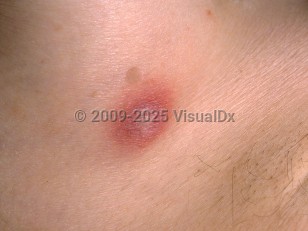Potentially life-threatening emergency
Ecthyma gangrenosum in Infant/Neonate
See also in: Cellulitis DDx,AnogenitalAlerts and Notices
Important News & Links
Synopsis

Ecthyma gangrenosum (EG) is a cutaneous manifestation of gram-negative bacteremia, most commonly secondary to Pseudomonas aeruginosa. It is seen predominantly in immunocompromised patients; however, characteristic clinical lesions can also develop in immunocompetent individuals without associated sepsis.
Risk factors include immunodeficiency syndromes or immunosuppressive therapy, or chronic disease states such as chronic lung disease, chronic neurological disease, severe burns, malnutrition, and diabetes mellitus. Preceding viral or upper respiratory illnesses with group A Streptococcus have also been reported. Some pediatric patients were discovered on development of EG to have underlying intraabdominal or other internal abscesses. EG is particularly common in the pediatric oncology population, commonly associated with neutropenia, hypogammaglobulinemia, and iatrogenic skin breakdown as a route for initial infection in patients without concurrent bacteremia. Systemic antibiotic treatment has also been reported as a predisposing factor.
Characteristic purpura or eschars develop when proliferating microorganisms invade the adventitia and media of blood vessels, causing occlusion and ischemic necrosis. Bacterial organisms include P aeruginosa, other species of Pseudomonas, Escherichia coli, Klebsiella pneumoniae, Vibrio vulnificus, Serratia marcescens, Aeromonas hydrophila, Citrobacter freundii, Stenotrophomonas maltophilia, Morganella morganii, and Moraxella species.
Severe complications such as osteomyelitis may occur from infection with P aeruginosa. The course depends on the underlying disease, but once manifestations of shock appear, the patient may quickly and irreversibly decline. Disseminated intravascular coagulation (DIC) may appear with gram-negative sepsis. Most patients are systemically ill and have associated fever, chills, and hypotension. Diabetic patients, however, may have few symptoms early in the disease. EG is seen in approximately 1%-13% of patients with P aeruginosa sepsis. The mortality rate ranges from 18%-96%.
Risk factors include immunodeficiency syndromes or immunosuppressive therapy, or chronic disease states such as chronic lung disease, chronic neurological disease, severe burns, malnutrition, and diabetes mellitus. Preceding viral or upper respiratory illnesses with group A Streptococcus have also been reported. Some pediatric patients were discovered on development of EG to have underlying intraabdominal or other internal abscesses. EG is particularly common in the pediatric oncology population, commonly associated with neutropenia, hypogammaglobulinemia, and iatrogenic skin breakdown as a route for initial infection in patients without concurrent bacteremia. Systemic antibiotic treatment has also been reported as a predisposing factor.
Characteristic purpura or eschars develop when proliferating microorganisms invade the adventitia and media of blood vessels, causing occlusion and ischemic necrosis. Bacterial organisms include P aeruginosa, other species of Pseudomonas, Escherichia coli, Klebsiella pneumoniae, Vibrio vulnificus, Serratia marcescens, Aeromonas hydrophila, Citrobacter freundii, Stenotrophomonas maltophilia, Morganella morganii, and Moraxella species.
Severe complications such as osteomyelitis may occur from infection with P aeruginosa. The course depends on the underlying disease, but once manifestations of shock appear, the patient may quickly and irreversibly decline. Disseminated intravascular coagulation (DIC) may appear with gram-negative sepsis. Most patients are systemically ill and have associated fever, chills, and hypotension. Diabetic patients, however, may have few symptoms early in the disease. EG is seen in approximately 1%-13% of patients with P aeruginosa sepsis. The mortality rate ranges from 18%-96%.
Codes
ICD10CM:
L08.0 – Pyoderma
SNOMEDCT:
17732003 – Ecthyma gangrenosum
L08.0 – Pyoderma
SNOMEDCT:
17732003 – Ecthyma gangrenosum
Look For
Subscription Required
Diagnostic Pearls
Subscription Required
Differential Diagnosis & Pitfalls

To perform a comparison, select diagnoses from the classic differential
Subscription Required
Best Tests
Subscription Required
Management Pearls
Subscription Required
Therapy
Subscription Required
References
Subscription Required
Last Reviewed:09/13/2017
Last Updated:08/05/2021
Last Updated:08/05/2021
Potentially life-threatening emergency
Ecthyma gangrenosum in Infant/Neonate
See also in: Cellulitis DDx,Anogenital
